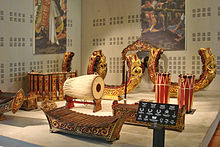Pi Phat

Pi Phat ( Thai : ปี่พาทย์ ) is the best-known music ensemble of classical Thai music, which is mainly composed of percussion instruments . It is used to accompany courtly and religious ceremonies and dances, shadow plays ( nang yai ) and mask plays ( khon ).
The Pi Phat developed u. a. from approximations to the Javanese tradition of gamelan . In Cambodia , a similar ensemble is called the Pin Peat . In Laos, Myanmar, Indonesia and the Philippines, there are orchestras that also feature humpback gong circles. Representations of musicians can already be found on the reliefs of the Angkor Wat temple.
A Thai pi-phat ensemble consists of at least six musical instruments.
The standard ensemble (Thai: pi phat khrueang ha - วง ปี่พาทย์ เครื่อง ห้า ) consists of pi nai (oboe - ปี่ ใน ), ranat ek (wooden xylophone - ระนาดเอก ), khong wong yai (gong - ฆ้องวง ใหญ่ ), ching ( cymbal - ฉิ่ง ) and the two barrel drums taphon ( ตะโพน ) and klong that ( กลอง ทัด ).
With the eight-person line-up ( pi phat khrueang khu - วง ปี่พาทย์ เครื่อง คู่ ), a further xylophone with a deeper sound ( ranat thum - ระนาดทุ้ม ) and a second, acoustically brighter gong ( khong wong lek - ฆ้องวง เล็ก ) are used, for ten to fourteen-member pi phat khrueang yai ( วง ปี่พาทย์ เครื่อง ใหญ่ ) additional instruments such as B. Xylophones ( ranat ek lek - ระนาดเอก เหล็ก - and ranat thum lek - ระนาดทุ้ม เหล็ก ) with metal bars.
In September 1900 in Berlin , Carl Stumpf documented the music of a pi-phat ensemble from a guest theater group from what is now Thailand on 24 Edison phonograms . This laid the foundation stone for the Berlin phonogram archive and also for comparative musicology in Germany.
Other classic Thai ensembles are Khruang sai and Mahori ( similar to the Cambodian Mohori ). The oboe is not used in the Mahori.
literature
- Phra Chen Duriyanga : Siamese Music. In: Asian Music, Vol. 13, No. 2, University of Texas Press, 1982, pp. 55-90
- Bussakorn Sumrongthong, Neil Sorrell: Melodic Paradoxes in the Music of the Thai pi-phat and Javanese gamelan. In: Yearbook for Traditional Music, Vol. 32, 2000, pp. 67-80
- Carl Stumpf : Sound system and music of the Siamese . Contributions to acoustics and musicology 3, 1901, pp. 69–138
